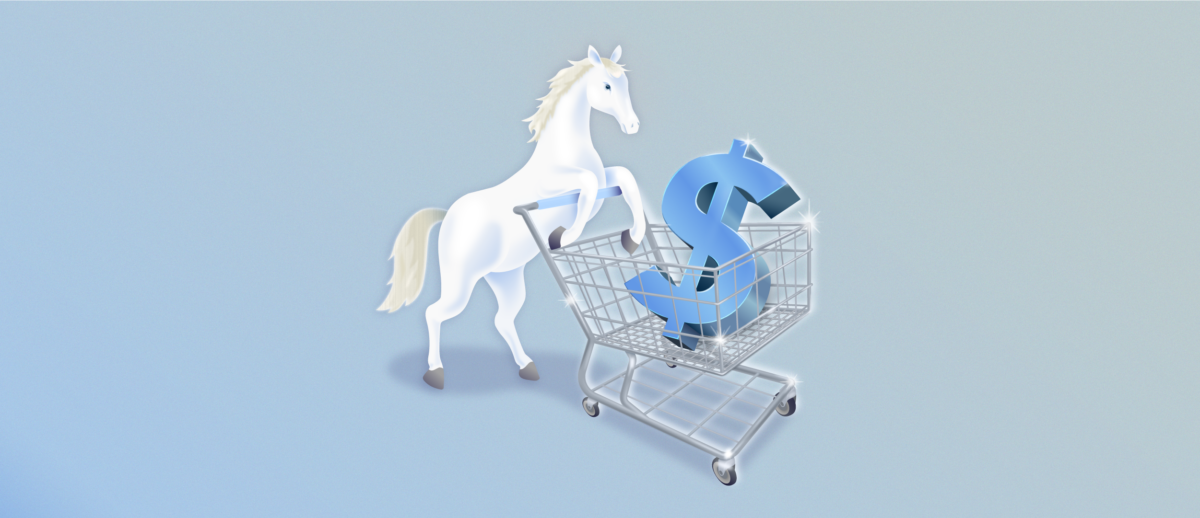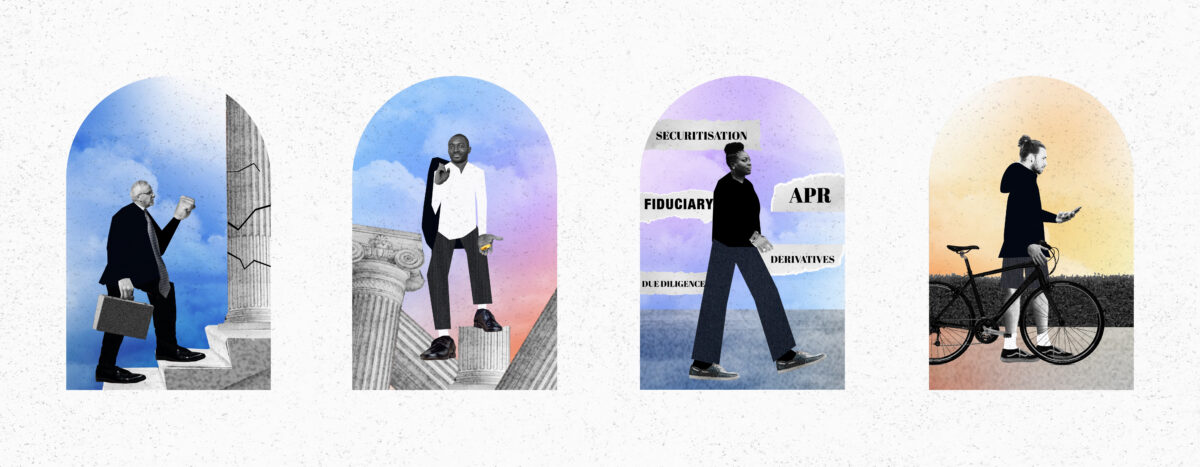INTRODUCTION
It’s more than just a feeling: The world is speeding up.
Scientific discoveries are proliferating faster than ever, and so are the creation and adoption of the new technologies that flow from them.
- Sequencing a human genome for the first time took 13 years and $2.5 billion, while today it can be done in weeks for just a few hundred dollars.1
- It took the personal computer 25 years to be adopted by 75 percent of households in the United States, half as long as it took telephones and automobiles to reach the same prevalence.
- The cell phone adoption rate was more rapid, reaching 90 percent of the U.S. population in about 25 years, with most of the uptake happening between 1990 and 2005.23
We are even walking faster, talking faster and communicating more often.
- In the decade between 2001 and 2011, the average number of words spoken per minute jumped from 145 to 170.4
- From 2014 to 2018, the number of times people checked their phones per day jumped from 33 to 46.
- Collectively, we now glance at our smartphones 185 million times per day in the United States.5
- The subjective sense that time speeds up may even be hardwired into our brains, quickening as we age.
Acceleration and the new media paradox
What we call a brand – that collection of ideas, visual cues and promises that we associate with a particular company or person – is of paramount importance in the age of acceleration.
With less time to sift carefully through each input, and with new inputs always arriving, consumers have little choice but to rely on rapid assessments, aided primarily by the unconscious mind rather than conscious calculation. Where once the sense of a brand was made from the slow, deliberate dissemination of a select number of images and messages, brand identity today must be buoyed by content continuously pushed to every available channel, without delay and without end.
The world’s acceleration, combined with the widest availability of information in history, has also changed consumer preferences for the way content is packaged.
In the days of analog media, the most influential books, films and periodicals had to pass through a bottleneck kept narrow by the fixed cost of producing and distributing physical media. If you could influence what came through the bottleneck, you could influence the consciousness of wide swaths of the mass media audience.
When the internet first emerged, the digitization of analog forms like music and newspapers diluted the influence of those who oversaw what made it through the bottleneck. The riot of newly available information streams gave rise to new celebrities like bloggers and social media stars. “Surfing the web,” or casting a wide net of largely uncritical attention to dozens or even hundreds of different websites, was seen as the surest path to the truth. More information equaled more wisdom.
But as we became accustomed to an abundance of information, we discovered the classic consumers’ paradox: Consumption takes time, which is the one resource we cannot make more of.
A media environment defined by scarce printed material and airwaves will never return, but time scarcity has never left us and never will. Deprived of old-guard bottlenecks, we are beginning to see the wisdom of creating new ones.
For media consumers, this has resulted in the rise of several new (and new again) formats that promise relevance and convenience. The newsletter, for example, offers a quick, daily, reliable read on what’s important to a defined community, saving its readers the time of having to scan several sources. There is also a profusion of new smartphone apps, some from legacy media brands and some from upstarts, that promise to deliver only the content that is worth giving up precious time to consume.
For brands, which are increasingly becoming networks of new knowledge, acceleration has created a growing opportunity to be the preferred source of truth for consumers and customers. The key challenge? Summoning the organizational discipline to create content that only and always demonstrates respect for time.
What defines time-worthy content?
Here’s the good news: What defines powerful content in a time-constrained world are the same things that always have. Good stories crack open our minds and hearts. They make us feel bigger than ourselves. They satisfy our hunger for wonder, wisdom and delight.
- Wonder stories lean toward the epic – they’re the ancient myths and everyday superhero tales that inspire us to strive for more.
- Wisdom stories share what’s useful, from universal truths to practical, hard-won tips.
- Delightful stories jolt our lives with unbridled fun and excitement.
In a world with less and less sand in the hourglass, these timeless tenets hold true. What has changed is our ability to focus on adhering to them – individually and, crucially, as storytelling organizations. The speed and volume of the ideas, insights and experiences that inform great stories have exploded. And so has the number of stakeholders that must be satisfied with the end product.
A framework for strategic storytelling in a time-constrained world
For people who trade in information and influence, it’s not enough to just create at the speed of social media or become multitasking media-consumption machines. Given the number of varied voices that must contribute to a creative process, what’s needed is a defined framework for guiding decisions that lead to the creation – and curation – of content that matters and makes an impact.
In a branded storytelling enterprise, all manner of creative professionals work toward the same ultimate objective. But writers, designers, strategists, client services specialists, data scientists … (the list goes on) come to the table with their own sets of interests and informational contexts. Each of their perspectives is necessary but, unchecked, the creative collision of their worldviews can lead to unproductive conflict and waste.
In a time-constrained world, speaking the same language and working from the same set of assumptions can mean the difference between making or missing a deadline and winning or losing a project.
We may not be able to master every creative discipline but, increasingly, we won’t succeed as individuals or organizations if we can’t embrace a multihyphenate sensibility.
Every challenge is different, but all our creative decisions should be evaluated against a set of four key filters.

Integrity: Are we building trust?
No matter how simple or transactional a piece of content might be, it still establishes – or at least sets the stage for – a relationship. And, in any relationship, trust is elemental. That’s especially true when time is in short supply.
In an environment where information is churning faster and more abundantly than ever, people will stick with the sources they trust and get ruthless with the ones that betray them. For storytellers, that means being accurate, authentic and true to the brand identities you represent.
Intentionality: Are we being deliberate?
If you spend enough time in the black holes of the internet, you will eventually stumble upon some treasure. Likewise, if you invest enough money or time in creative storytelling, you will eventually make an impression. But the fastest path to storytelling success is through focused action – by creating with consideration and calculation at every step.
This may sound obvious. But, in the face of a looming deadline, with seemingly a million distractions dividing your attention, it’s all too easy to create content merely for content’s sake if you haven’t articulated a distinct goal. Ask yourself: How does this decision align with an overall strategy? Is it based on instinct or on actual insights? And how will we determine progress? The answers can be simple – even one word is fine – but the basic exercise of defining a specific intention will keep you on the right course.
It’s also worth noting that this approach doesn’t preclude happy accidents and iteration from playing their roles in the creative process. It just helps to ensure that serendipity doesn’t sideline real strategy.
Prescience: Are we evolving our creative and accounting for an evolving audience?
We all know that effective content must connect with its audience. But what works with that audience now may not have worked with them last year, and may not work with them again next year. Audiences have always evolved, but that evolution is happening faster and on more planes than before.
That makes the job harder, but more interesting, for creative storytellers. We must not only make sure that our content resonates with a reality our audience is experiencing in this particular moment; we must also help them anticipate a fast-approaching future.
At the same time, we have to be mindful of pushing the boundaries of our own craft. New formats can quickly progress from avant-garde to also-ran, and if we can’t keep up, we lose our own relevance.
Efficiency: Are we minimizing wasted resources and maximizing value?
From the volume of resources you invest in a project to the economy of expression reflected in the final product, efficiency is everything. That doesn’t mean you can’t use world-class tools or premium materials. Or spend decades writing and rewriting the great American novel. But every input must be considered in the context of a desired output and expected gain.
Creating and curating efficiently also demands that we take advantage of the full spectrum of formats and platforms available. A 2,500-word white paper may not be the most time-efficient format for everyone you want to reach. That’s why it’s so important to atomize content – to break it down and repurpose it – to make the most of the creative work you’ve done.
Putting this framework to use
How these principles come alive for each storyteller and each storytelling organization will vary depending on priorities, goals and demands. But in our years of experience, we’ve uncovered a few applications that have brought success to our teams and clients.
Integrity: Continually expand your circles of credibility
The job of establishing credibility is never done. As individuals, we’re constantly evaluating whom and what to trust, which means that as organizations, we can never stop proving our value.
That starts, of course, with the people we bring in. Award-winning designers and newsroom-tested journalists have always formed the backbone of our team. And, as we’ve grown and our client needs have shifted, we’ve thoughtfully forged partnerships that further enhance our storytelling talent and capabilities.
Recently, for example, we launched Penguin Random House Studios @ SJR to enable our clients to tap into a deep pool of trusted experts across a wide range of disciplines. From generating cutting-edge industry trends to providing upstream access to market-defining points of view, this partnership is one way we ensure that our clients remain trustworthy brokers of the information their audiences need.
Intention: Immerse yourself in data you can trust
Intention starts with articulating a clear purpose, but realizing that goal requires myriad micro-calculations every day. Accurate, representative data is crucial to navigating those decisions successfully.
In addition to traditional vehicles for gathering data, we believe in uncovering information that really gets to the heart (or mind) of how audiences experience our content. That’s why we recommend that clients use a wearable tracker from Immersion Neuroscience that measures engagement. Using a person’s heart rate, it measures oxytocin, the so-called “love hormone” released when people experience strong positive emotions.
Creating a stream of constant feedback ensures that you have the information you need to measure progress while establishing a recurring forcing function for recommitting to your vision.
Prescience: Give evolution a seat in the C-suite
Caught up in the demands of the day-to-day, it can be hard to prioritize future possibilities over immediate needs. But companies and brands that can’t evolve will increasingly find their talent and client pipelines drying up. To show just how critical evolution is to your enterprise, consider appointing a senior leader “chief evolution officer” in function, if not in name.
For example, we created an internal consulting agency called Outside Minds that is responsible for making sure our content teams are evolving both their creative approaches and understanding of our clients’ target audiences. For brands that have been SJR clients for at least six months to a year, Outside Minds brings a fresh perspective and up-to-the-minute market savviness to the engagement. As the group grows, it not only pushes the teams it works with directly, but also serves as an innovation engine for the entire agency.
Efficiency: Cut the cutting room floor
We’re not saying you shouldn’t “kill your darlings.” But once you kill them, you might be able to find them a click-worthy afterlife.
“Atomization,” the process of breaking down a narrative into smaller, discrete pieces to optimize impact, has long been a foundational part of our storytelling strategy. Across all of our engagements, we isolate quotes, statistics, compelling graphical angles and under-appreciated angles from longer-form content and give them new lives across all digital (and physical) platforms.
Atomization can also be applied to any of the raw material developed as part of a creative undertaking. When a chef has an opportunity to work with white truffles, you can be sure she doesn’t waste a whit. Your talent’s time is equally precious. By packaging the work behind the work into content for brand-building and insight-gathering purposes, you can maximize that critical resource.
Conclusion
In this age of acceleration, when we have more knowledge and intelligence at our fingertips than ever before, it can too often feel like we’re as short on control as we are on time. But that simply isn’t true – the power to make the most of your organization’s time is in your hands. With the right mindset and talent, you can still be influence-rich in a time-poor world.
1 Heusel, Johnathan and Neil Richards. “Now we can cheaply sequence DNA, how do we store all that data?” WIRED. January 15, 2018. Accessed January 5, 2019: https://www.wired.co.uk/article/precision-medicine.
2 McGrath, Rita. “The Pace of Technology Adoption is Speeding Up.” Harvard Business Review. November 25, 2013. Accessed April 20, 2017: https://hbr.org/2013/11/the-pace-of-technology-adoption-is-speeding-up.
3 Felton, Nicholas. “Consumption Spreads Faster Today.” The New York Times. February 10, 2008. Accessed January 28, 2019: https://archive.nytimes.com/www.nytimes.com/imagepages/2008/02/10/opinion/10op.graphic.ready.html.
4 Ross, Colleen. “How technology is turning us into faster talkers.” CBC. October 31, 2011. Accessed January 5, 2018: https://www.cbc.ca/news/canada/how-technology-is-turning-us-into-faster-talkers-1.1111667.
5 Eadiciccio, Lisa. “Americans Check Their Phones 8 Billion Times a Day.” Time. November 11, 2014. Accessed January 5, 2018: http://time.com/4147614/smartphone-usage-us-2015/.





